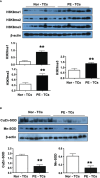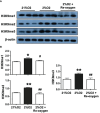Oxidative stress contributes to hypermethylation of Histone H3 lysine 9 in placental trophoblasts from preeclamptic pregnancies
- PMID: 38737551
- PMCID: PMC11084288
- DOI: 10.3389/fendo.2024.1371220
Oxidative stress contributes to hypermethylation of Histone H3 lysine 9 in placental trophoblasts from preeclamptic pregnancies
Abstract
Background and objective: Aberrant epigenetic regulation and increased oxidative stress in the placenta play a significant role in placental pathophysiology and fetal programming in preeclampsia, a hypertensive disorder in human pregnancy. The purpose of the study is to investigate if hypermethylation of histone H3K9 occurs in placental trophoblasts from preeclampsia.
Methods: Trophoblasts were isolated and cultured from 14 placentas, 7 from normotensive pregnant women and 7 from preeclamptic pregnancies. Methylated H3K9 expression and antioxidant superoxide dismutase expression were determined by Western blot. We also examined consequences of oxidative stress and the downstream effects of histone methyltransferase inhibition on H3K9 expression associated with antioxidant CuZn-SOD and Mn-SOD expression in placental trophoblasts.
Results: We found that expression of mono-, di-, and tri-methylation of histone H3 lysine 9 (H3K9me1, H3K9me2 and H3K9me3) was significantly increased, p<0.01, which correlated with downregulation of antioxidant superoxide dismutase CuZn-SOD and Mn-SOD expression, in trophoblasts from preeclamptic placentas compared to those from uncomplicated control placentas. We further demonstrated hypoxia could promote histone H3K9 methylation in placental trophoblasts, and hypoxia-induced upregulation of H3K9me1, H3K9me2 and H3K9me3 expression was reversible when hypoxic condition was removed. In addition, we also uncovered that inhibition of methyltransferase not only prevented hypoxia-induced upregulation of H3K9me1, H3K9me2 and H3K9me3 expression, but also abolished hypoxia-induced downregulation of CuZn-SOD and Mn-SOD expression in placental trophoblasts.
Conclusions: These findings are noteworthy and provide further evidence that increased oxidative stress in the intrauterine environment is likely a mechanism to induce aberrant histone modification in placental trophoblasts in preeclampsia. Moreover, CuZn-SOD and Mn-SOD expression/activity are possibly H3K9 methylation-dependent in placental trophoblasts, which further suggest that oxidative stress and aberrant histone modification have significant impact on placental trophoblasts/fetal programming in preeclampsia.
Keywords: H3K9 methylation; hypoxia; oxidative stress; placental trophoblast; preeclampsia; superoxide dismutase.
Copyright © 2024 Gu, Cooper, Lewis, Zoorob and Wang.
Conflict of interest statement
The authors declare that the research was conducted in the absence of any commercial or financial relationships that could be construed as a potential conflict of interest. The author(s) declared that they were an editorial board member of Frontiers, at the time of submission. This had no impact on the peer review process and the final decision.
Figures



Similar articles
-
Upregulation of histone H3K9 methylation in fetal endothelial cells from preeclamptic pregnancies.J Cell Physiol. 2021 Mar;236(3):1866-1874. doi: 10.1002/jcp.29970. Epub 2020 Jul 23. J Cell Physiol. 2021. PMID: 32700783
-
Upregulation of METTL3 expression and m6A RNA methylation in placental trophoblasts in preeclampsia.Placenta. 2021 Jan 1;103:43-49. doi: 10.1016/j.placenta.2020.10.016. Epub 2020 Oct 13. Placenta. 2021. PMID: 33070036
-
Apelin/APJ system protects placental trophoblasts from hypoxia-induced oxidative stress through activating PI3K/Akt signaling pathway in preeclampsia.Free Radic Biol Med. 2023 Nov 1;208:759-770. doi: 10.1016/j.freeradbiomed.2023.09.030. Epub 2023 Sep 27. Free Radic Biol Med. 2023. PMID: 37774802
-
Epigenetic and non-epigenetic regulation of syncytin-1 expression in human placenta and cancer tissues.Cell Signal. 2014 Mar;26(3):648-56. doi: 10.1016/j.cellsig.2013.11.002. Epub 2013 Nov 9. Cell Signal. 2014. PMID: 24216608 Review.
-
Review: Reactive oxygen and nitrogen species and functional adaptation of the placenta.Placenta. 2010 Mar;31 Suppl(Suppl):S66-9. doi: 10.1016/j.placenta.2009.12.021. Epub 2010 Jan 27. Placenta. 2010. PMID: 20110125 Free PMC article. Review.
Cited by
-
Impact of air pollution exposure on cytokines and histone modification profiles at single-cell levels during pregnancy.Sci Adv. 2024 Nov 29;10(48):eadp5227. doi: 10.1126/sciadv.adp5227. Epub 2024 Nov 29. Sci Adv. 2024. PMID: 39612334 Free PMC article.
References
Publication types
MeSH terms
Substances
LinkOut - more resources
Full Text Sources

